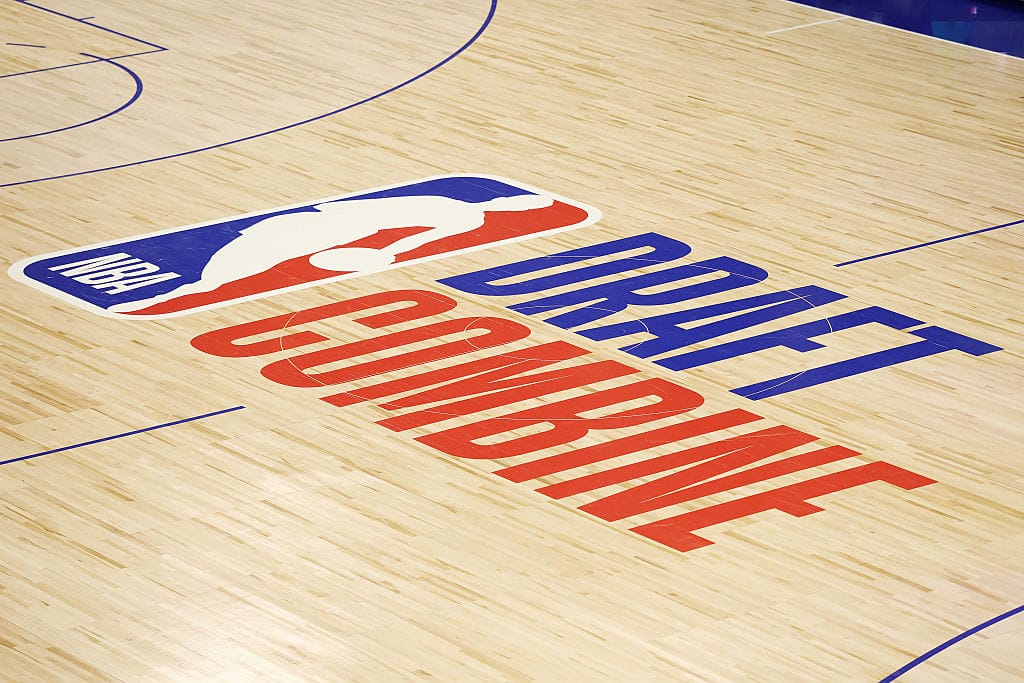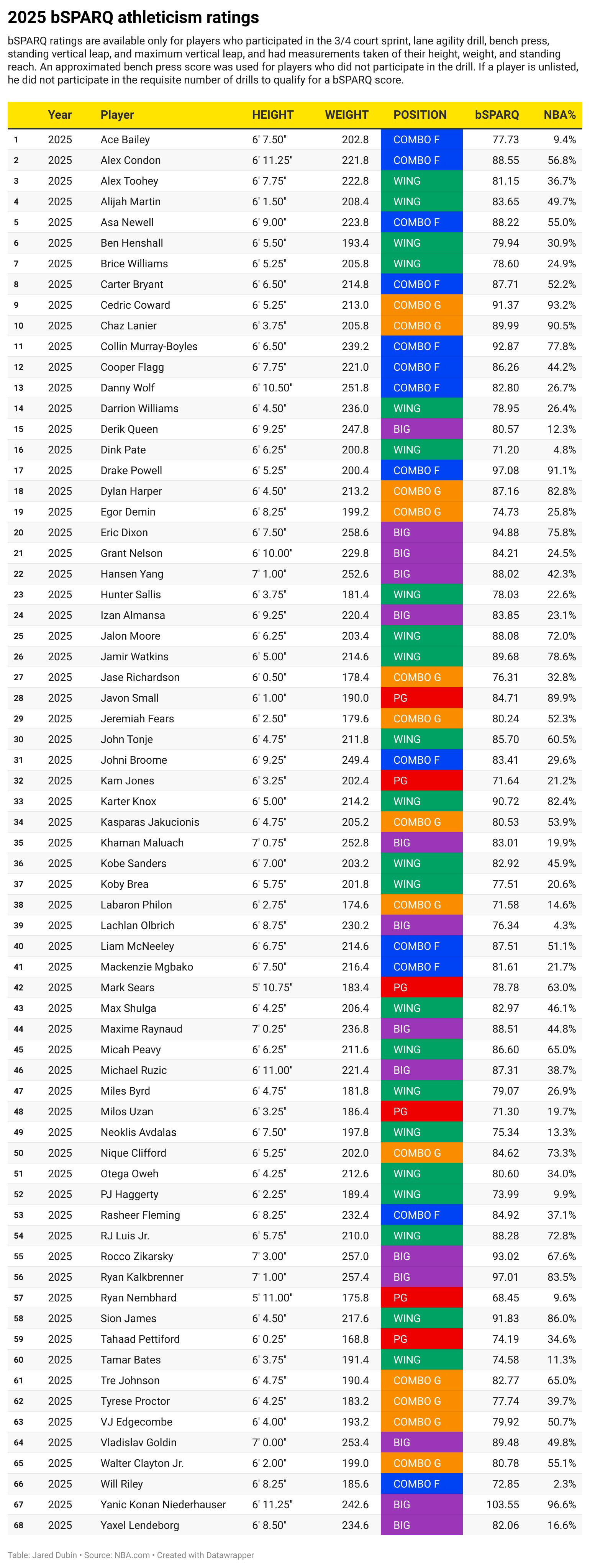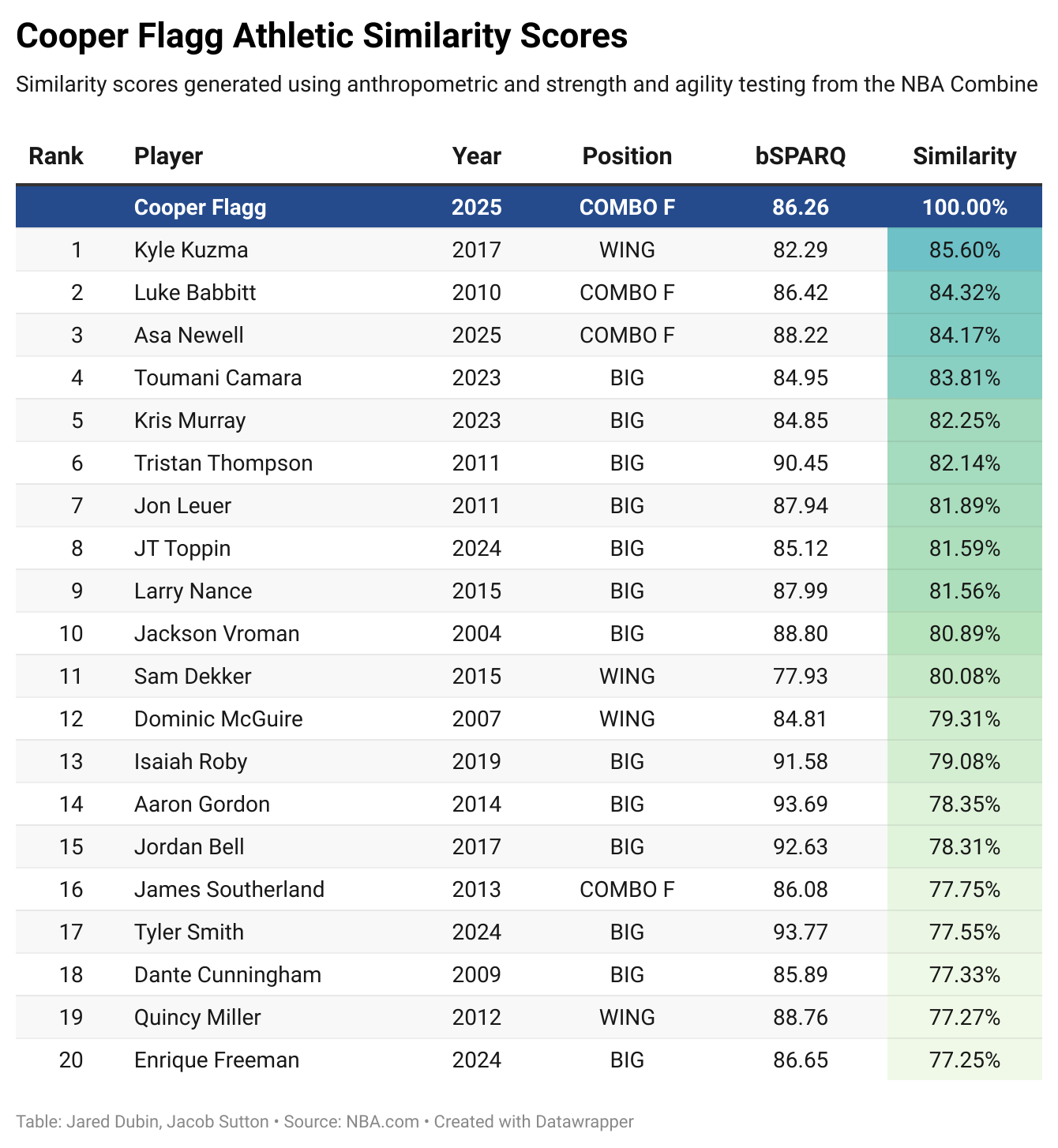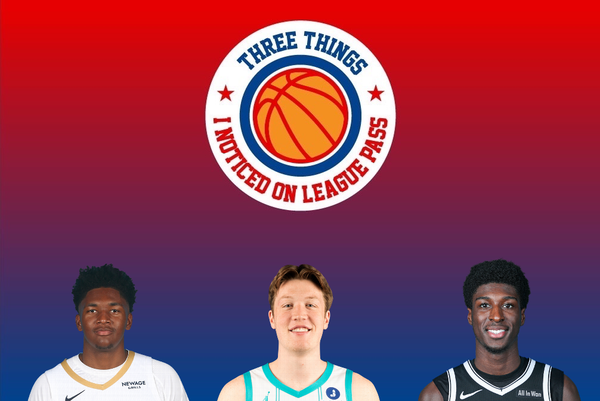The best and worst athletes in the 2025 draft class
Where do Cooper Flagg, Dylan Harper, and others check in?

The NBA finally, at long last, posted the results from the combine. It only took three full days, but we got our hands on it. So just like last year, I've compiled bSPARQ ratings for everyone who participated in the event. For a full explainer on bSPARQ, click here.
As was the case last year, any prospect who is healthy enough to participate, had to do so, which means that unlike in many previous seasons, we actually have strength and agility data for the top players in the class. In all, 68 of the 72 players at the combine qualified for bSPARQ ratings, with four players sitting out due to injury. They'll have to make up their testing at a later date, and the international players who did not attend the combine will have their own combine later this month. Once those players participate, I'll add them to the database.
Before we get into the data and a few of my key takeaways, please remember that bSPARQ does NOT measure how good a player is at basketball. It strictly measures his performance in athletic testing at the combine relative to his peers.
Got all that? Great. Let’s get into it.

- As you can no doubt see at the very top, Ace Bailey tested as a 9th percentile athlete for a combo forward. A few things to note here:
- First, the positional designations are automated based on how a player is listed by the NBA at the combine. Bailey was listed as SF-PF, which makes him a combo forward. If he was listed as SF, he'd be a wing, in which case he would check in with 21st percentile athleticism.
- Much of Bailey's poor testing results are based on the fact that he didn't jump very high for a player of his size. A player who weighs just 202.8 pounds posting a standing vertical of only 27.5 inches and a max vertical of 34.5 inches isn't going to fare very well.
- If Bailey were heavier and posted the exact same numbers, his bSPARQ would climb accordingly. Had he checked in at 225 pounds, for example, he'd be in the 33rd percentile for a combo forward and 52nd percentile for a wing. Alas, that's not what happened here.
- Poor athletic testing for a combo forward Bailey's size isn't a death sentence if you're skilled enough. Kevin Durant, a player to whom Bailey has compared himself, was only in the 10th percentile for a combo forward, largely because he, too, was very skinny and didn't post elite testing numbers. (KD's bench press killed him, famously.)
- Projected No. 1 overall pick Cooper Flagg tested as only a 44th percentile athlete. Similar to Bailey, that would change if you listed him as a wing, as he'd jump to the 63rd percentile. He has a really eclectic list of closest athletic comparables in the bSPARQ database. Note that the similarity scores are based ONLY on size measurements and strength and agility testing numbers. They do not have a performance or playing style component. More on these comparisons for other players in the class, tomorrow.

- Unlike his former Rutgers teammate (Bailey), Dylan Harper put together some really good testing numbers — largely because he weighed in at 213.2 pounds, and as mentioned, bSPARQ scales with weight. Harper checked in 3 inches shorter than Bailey, but 11 pounds heavier, and he lapped Bailey in both vertical jumps, which figures heavily into bSPARQ. Even if Harper and Bailey were both listed as wings, Harper's NBA% would be much higher because of that factor. As it stands, Harper's 82nd percentile bSPARQ is eighth-best in the class.
- Projected top-five pick VJ Edgecombe tested as almost an exactly average athlete for a combo guard. He really disappointed in the lane agility drill, which dragged down pretty good scores in the other tests.
- Duke big man Khaman Maluach posted a 19th percentile bSPARQ and really did not test very well. He had one of the 25 worst shuttle run times in the entire database at 3.44 seconds, and he had only a 24-inch standing vert and 30-inch max vert. He's projected to go pretty high in the lottery so I thought that was really interesting.
- Duke guard Sion James and Oklahoma forward Jalon Moore became two of just 17 players to complete the 3/4 court sprint in 3.00 seconds or less. James checked in as an 86th percentile athlete after also posting strong lane agility and shuttle run times, and jumping 39.5 inches (max) at 217.6 pounds. He has great size and tested really well for a wing.
- With a 37.5-inch standing vert, UNC's Drake Powell tied for the seventh-best mark in combine history. His 43-inch max vert tied for 14th. Combined with his electric shuttle run, Powell tested in the 91st percentile, third-best among any player in the class.
- Alabama guard Mark Sears apparently grew half an inch over the last year. In 2024, he tied Shane Larkin and Sherron Collins as the shortest player in combine history, but this year he measured in at 5'10.75". He didn't do as well in the testing, though, jumping lower than he did last year despite weighing 9 pounds less.
- On the other end of the spectrum, Australia's Rocco Zikarsky is the fifth player in combine history to measure in at least 7'3". He posted testing numbers very similar to Zach Edey. Like, scarily similar. But because Edey weighed 299 pounds to Zikarsky's 257, Edey had a 92nd percentile bSPARQ while Zikarsky's is only 67th percentile.
- Creighton's Ryan Nembhard posted the lowest standing reach in combine history at 7'10". (Correction: This was a Google Sheets error. Sheets for some reason sorts 7'10" as being lower than 7'2" through 7'9", presumably because the second portion of the number begins with a 1. It's very stupid, but that's what happened here.) Nembhard also weighed only 175.8 pounds, and combined with poor lane agility and vertical numbers for a player his size, he has a 9th percentile bSPARQ. His brother Andrew, currently in the Conference Finals for a second consecutive year, tested much better (not only because he was bigger), even if he still posted a below-average bSPARQ at his position. Ryan's raw bSPARQ was the lowest in the class, but four players checked in lower than the 9th percentile because they're listed at different positions.
- Speaking of those players... Illinois' Will Riley checked in with the worst bSPARQ percentile in the class. Listed as a combo forward but weighing only 185.6 pounds, Riley put up a big-man-esque lane agility time and only jumped 27.5 inches standing and 32 inches max.
- The most athletic player in the class: Penn State big man Yanic Konan Niederhauser. He posted the highest raw bSPARQ and he checked in as a 96th percentile athlete for a big man. And he did it despite weighing just 242.6 pounds, which is CRAZY. Niederhauser posted an elite shuttle run time — faster than a bunch of guards — and had a standing vert of 33.5 inches and max vert of 37 inches.
- Just so you can see how much size and weight and position can change things, consider this: Michigan's Danny Wolf (82.80) and Texas' Tre Johnson (82.77) posted nearly identical bSPARQs. But Wolf is a 6'10.5", 251.8-pound combo forward and Johnson is a 6'4.75", 190.4-pound combo guard, so Wolf clocked in with a 26th percentile bSPARQ while Johnson is in the 65th percentile.





